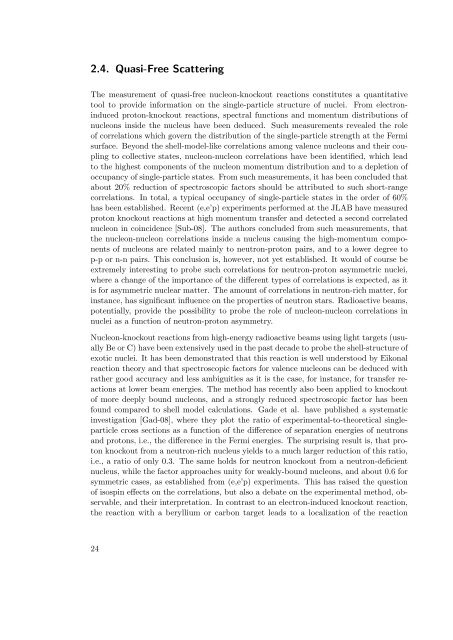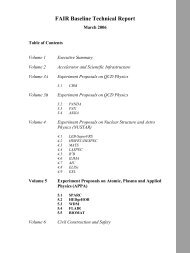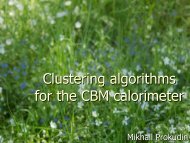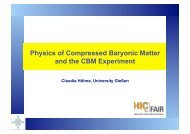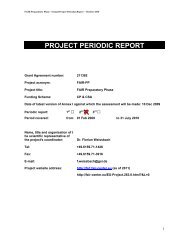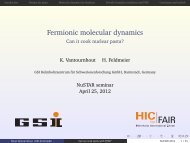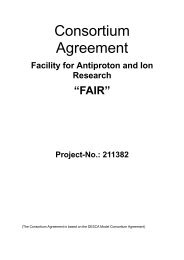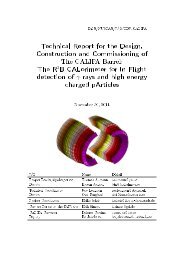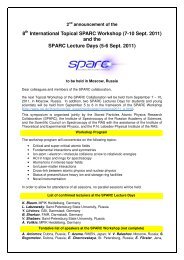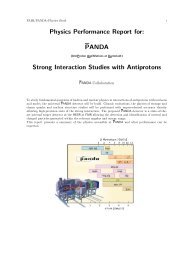NeuLAND - FAIR
NeuLAND - FAIR
NeuLAND - FAIR
You also want an ePaper? Increase the reach of your titles
YUMPU automatically turns print PDFs into web optimized ePapers that Google loves.
2.4. Quasi-Free Scattering<br />
The measurement of quasi-free nucleon-knockout reactions constitutes a quantitative<br />
tool to provide information on the single-particle structure of nuclei. From electroninduced<br />
proton-knockout reactions, spectral functions and momentum distributions of<br />
nucleons inside the nucleus have been deduced. Such measurements revealed the role<br />
of correlations which govern the distribution of the single-particle strength at the Fermi<br />
surface. Beyond the shell-model-like correlations among valence nucleons and their coupling<br />
to collective states, nucleon-nucleon correlations have been identified, which lead<br />
to the highest components of the nucleon momentum distribution and to a depletion of<br />
occupancy of single-particle states. From such measurements, it has been concluded that<br />
about 20% reduction of spectroscopic factors should be attributed to such short-range<br />
correlations. In total, a typical occupancy of single-particle states in the order of 60%<br />
has been established. Recent (e,e’p) experiments performed at the JLAB have measured<br />
proton knockout reactions at high momentum transfer and detected a second correlated<br />
nucleon in coincidence [Sub-08]. The authors concluded from such measurements, that<br />
the nucleon-nucleon correlations inside a nucleus causing the high-momentum components<br />
of nucleons are related mainly to neutron-proton pairs, and to a lower degree to<br />
p-p or n-n pairs. This conclusion is, however, not yet established. It would of course be<br />
extremely interesting to probe such correlations for neutron-proton asymmetric nuclei,<br />
where a change of the importance of the different types of correlations is expected, as it<br />
is for asymmetric nuclear matter. The amount of correlations in neutron-rich matter, for<br />
instance, has significant influence on the properties of neutron stars. Radioactive beams,<br />
potentially, provide the possibility to probe the role of nucleon-nucleon correlations in<br />
nuclei as a function of neutron-proton asymmetry.<br />
Nucleon-knockout reactions from high-energy radioactive beams using light targets (usually<br />
Be or C) have been extensively used in the past decade to probe the shell-structure of<br />
exotic nuclei. It has been demonstrated that this reaction is well understood by Eikonal<br />
reaction theory and that spectroscopic factors for valence nucleons can be deduced with<br />
rather good accuracy and less ambiguities as it is the case, for instance, for transfer reactions<br />
at lower beam energies. The method has recently also been applied to knockout<br />
of more deeply bound nucleons, and a strongly reduced spectroscopic factor has been<br />
found compared to shell model calculations. Gade et al. have published a systematic<br />
investigation [Gad-08], where they plot the ratio of experimental-to-theoretical singleparticle<br />
cross sections as a function of the difference of separation energies of neutrons<br />
and protons, i.e., the difference in the Fermi energies. The surprising result is, that proton<br />
knockout from a neutron-rich nucleus yields to a much larger reduction of this ratio,<br />
i.e., a ratio of only 0.3. The same holds for neutron knockout from a neutron-deficient<br />
nucleus, while the factor approaches unity for weakly-bound nucleons, and about 0.6 for<br />
symmetric cases, as established from (e,e’p) experiments. This has raised the question<br />
of isospin effects on the correlations, but also a debate on the experimental method, observable,<br />
and their interpretation. In contrast to an electron-induced knockout reaction,<br />
the reaction with a beryllium or carbon target leads to a localization of the reaction<br />
24


